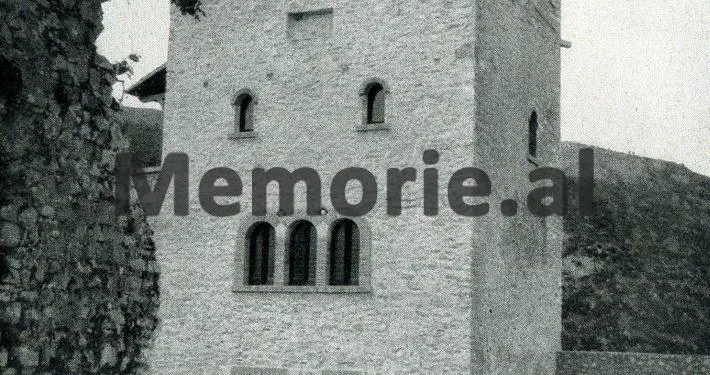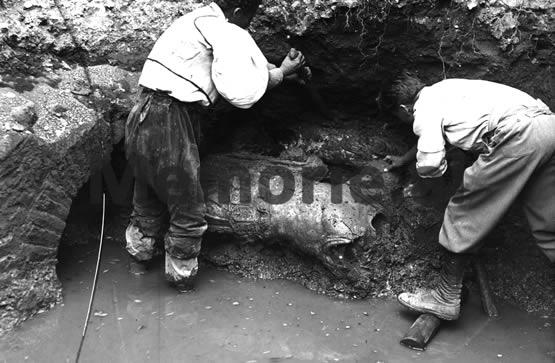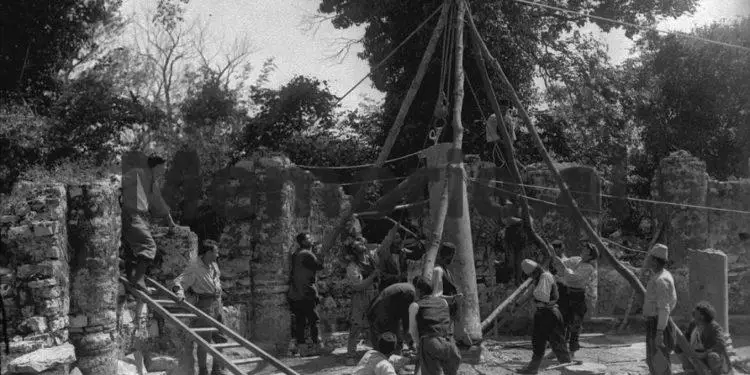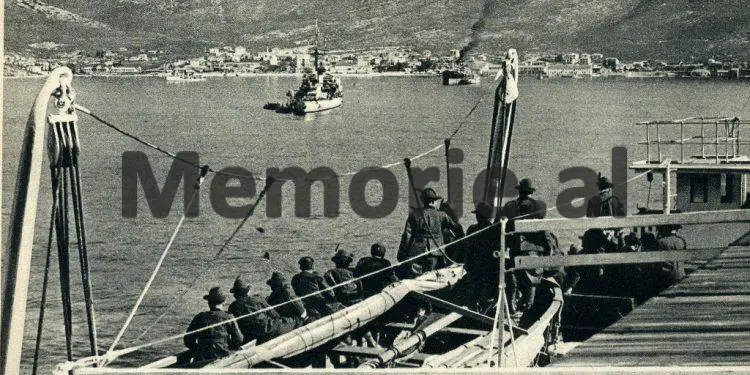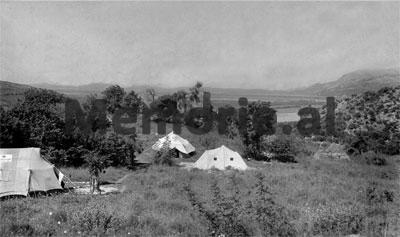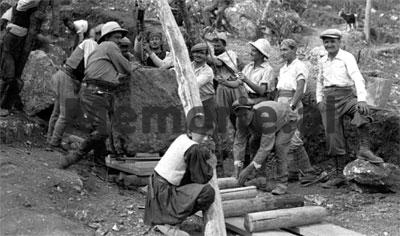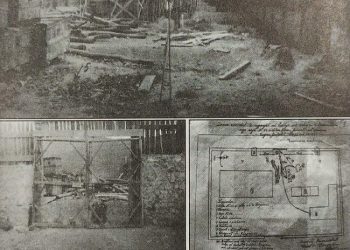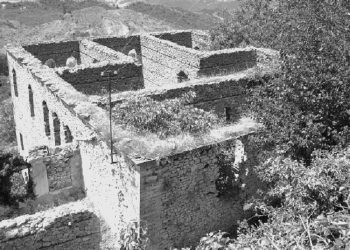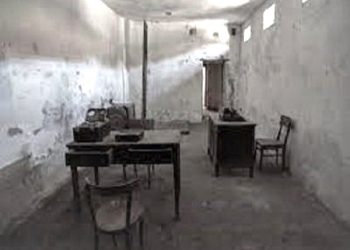Dashnor Kaloçi
Memorie.al publishes the unknown story of the Italian scholar, Ciriaco dei Pizzicolli from Ancona, one of the first discoverers of the ancient city of Butrint who in 1453 spent Christmas night there, where he was amazed by the magnificent walls of that town and he had another merit, as he collected data and documents, which even today constitute an invaluable value. The unknown history of that town, from antiquity onwards, in the eyes of the Italian scholar, Pelligrino di Sestieri, who was long concerned with the discoveries of Ugolin and the cultural heritage of Albanians and in his study entitled “Antica Albania nelle richerche arceheologiche ”(Ancient Albania, under the archeological ruins”), which was published in the magazine “DRINI” which was published in the years 1939-1943 by the National Tourism Authority in Albania, among other things he writes: “In this small book everything is shown with an exemplary linguistic ease and beauty; is a book that is addressed not only to specialists but to the masses of the people; addresses him as an Italian whom he wanted to know as much as he did as a representative of Italian archeology; as well as the Albanian reader, who in this work of writing and easy to read, receives notification on his national archaeological wealth ”.
A few years ago, as a result of a great research work done by the joint Albanian-English archaeological expedition, led by the co-directors, prof. Richard Hoges and prof. Ilir Gjipali, from the underground of the ancient town of Butrint was discovered and another archeological trace came to light. According to various scholars and archaeologists, that archaeological find is thought to be the forum, or Roman center of that ancient city, whose excavations began in the second decade of the last century, by the famous Italian archaeologist, Professor Luigi Maria Ugolini and then continued by his close associate, Professor Piero Marconi. According to many specialists and archaeologists, the latest discovery in the ancient town of Butrint, in addition to enriching the “inventory” of Albania’s cultural heritage, will give more value to that town in terms of cultural tourism, making it town to become even more object of pilgrimage by foreigners. But the first discovery a few years ago in Butrint by the Albanian-British expedition, as is already known, is not the only one of this nature. He has been preceded by many other discoveries, since the first decades of the last century, when the first excavations began there by the Italian expedition, which had concluded a series of agreements with the Albanian governments of that time. But for a clearer and more detailed picture of the excavations and discoveries made in Butrint, we know a study done by the Italian scholar, Sestieri, in 1941, which sheds light on the ancient history of that famous town, as and for the hard work and discoveries he made there for nearly two decades, the famous Italian archaeologist, prof. Luixhi Maria Ugolini. This study by the Italian Pelligrino di Sestieri, entitled “Antica Albania nelle richerche arceheologiche”, (Ancient Albania, under the archaeological ruins “), which was published in the magazine” DRINI “published in 1939-1943 by the National Tourism Authority in Albania, Memorie.al is publishing it in full, making no difference from the original text written at that time, where only the subheadings are editorial.
“Ancient Albania, under the archeological ruins”
Pizzicolli, the first Italian archaeologist in Albania
This volume was written in 1928 by the well-known scientist and archaeologist Ugolini. Although the writing has a long history, and although at this time and above the archaeological discoveries in Albania have increased to a very significant extent, to add the monumental heritage of the country, the book in question has a relevance of relevance. It begins with a note on the work of the Italian Renaissance Humanists, who were the founders of archeology. Among them the first place for seniority is occupied by Ciriaco dei Pizzicolli from Ancona. This was one of the first old scholars to be brought from Albania, where he often returned, bringing to light places hitherto unknown and which; in ancient times they were important; in addition to this action there was also a great merit in the collection of some documents which today are of inestimable value; also, Pizzicolli collected and copied some inscriptions that are lost today.
Pizzicolli in 1435 in Butrint for Christmas
In 1435 he spent Christmas night in Butrint which he greatly admired for those magnificent walls and for its past grandeur. To a curious coincidence, this city, which was discovered by an Italian (Pizzicolli), after five centuries of silence and oblivion, is discovered by another Italian, Ugolini. In 1924 he followed the path that Pizzicolli had followed in his time in Albania. The purpose of this trip was the discovery of archaeological antiquities, the study of Illyrian civilization, and the connection of this civilization with the lands beyond the Adriatic, and finally, the study of classical monuments and traces left by Rome. In this little book everything is told with an exemplary linguistic ease and beauty; is a book that is addressed not only to specialists but to the masses of the people; addresses him as an Italian whom he wanted to know as much as he did as a representative of Italian archeology; as well as the Albanian reader who in this work of writing and readable very easily, receives notification on his national archaeological wealth. Ugolini especially is not limited to the simple and dry observation of historical objects and writings but reconstructed the life of the ancients and understood the generous goals of his scientific mission, they have always given him the greatest and possible help, allowing him to connect that Italian-Albanian archeological agreement, which was not the first Italian recognition of research in Albania, but also a generous and sincere hostage to the friendship that bound the two Adriatic Nations. – Ugolini whom I knew very well, because he had worked in the most difficult times of his life – he sincerely loved Albania. His greatest desire was to value Albania in the field of studies and scientific research, and through his efforts as a researcher to show the world the generosity of Albanian land. The prehistoric research he conducted provided practical evidence of what he had in mind. The arrival of the Illyrians in Albania is considered by Ugolin as the beginning of the protohistoric era from which we do not have sufficient and clear documents due to our insufficient information about Albania, which is followed by the shining example of the index by the late Ugolini, with Larger excavations and excavations would be completed so that the Illyrian civilization is known as well as the Greek and Roman civilizations.
Old cemetery found in Koman
A proof of the insufficiency of our notices is given to us by the Koman cemetery, the decorative items of whose tombs, although they belong to the front and the protohistoric decorative part, chronologically belong to a much later period; thus, they give us only a dry account of the civilization they represent. It is a typical phenomenon of pseudo-archaism which shows that some Illyrian tribes living among the mountains continued to use prehistoric items even when Roman legions passed through their lands; and in truth some of the tombs of Koman have an absolute date of the III and V century AD; for in addition to the purely Illyrian material, Roman coins of the late period of the empire were found there, as well as other items that allow all the equipment of the tomb to be dated to the 3rd or 5th century. Ugolini rightly says that this fact shows a spirit of loyalty that is found not only in Northern Albania, but also in Southern Albania. In confirmation of this, it presents two sculptural examples that represent female faces, one of them a bust of Fingja from the collection “Vlora”, the other is the famous monument that today unfortunately has lost, nicknamed “Vasha e Vlora”. Both of these works, works, the first in the Roman period and the second in the Greek, show the loyalty of the people who are imagined in Illyrian clothing, despite the fact that it also presents the fashion and manner of dress brought by the Greeks. Today, these examples are not the only ones, because I have added two more to the first two, and obviously from the other excavations it will be achieved with the pasun and others still. These sculptures show that the Illyrians also inhabited southern Albania, as evidenced by the discovery of the Illyrian-type fibulae in Phenicia (it is about Finiq, our note), and Butrint.
Ugolin’s book, important for Albanians
Ugolin’s book is of great importance for Albanians, because not only is it a book written to illustrate the antiquities of the country, or to show a tourist itinerary to intelligent people, but because it proves, based on the documents that archeology has given author, that the Albanian people has its own ethnic unity and that its race is one of the oldest races in Europe. Tue saw that in different places the same traces meet, it can certainly be attested to the proof that in all this earth, at a certain time inhabited a single people. Ugolini points out the connections between the Illyrians and the inhabitants of southern Italy. Archaeologically, glotologically, it has also been proven that: in addition to other witnesses of literary traditions, a part of the Illyrians crossing the Adriatic emigrated to southern Italy where they found better and more advanced cultural conditions. These announcements are also confirmed by legends. Thus, Pliny shows that Peucheci also married 9 Illyrian girls and from them were born 12 tribes of Puglia. According to Herodotus, the Eugenes of Venice were from the Illyrian tribe, and finally, according to Apian, the Illyrian was the son of Polyphemus, the Sicilian cyclops who lived under Mount Etna in Sicily. Toponymic and onomastic based glotological studies provide much more evidence on the relationship between these two countries; but of course, Ugolini in a work with the purpose of dissemination cannot go deeper into scientific features and thus is limited to indications, mentioning only the legends that are always coming out of the people and that more or less have a foundation of accuracy. On the other hand, one should not be surprised because the inhabitants of Old Albania have returned and crossed into Italy because the sea that separates them is narrow enough that a few hours of sailing are enough and therefore instead of functioning as a means of separation, it served as a road. relationship. On the proximity of Italy, Virgil in the two lines we are reproducing also talks about Aeneas’ journey: “Provehiunur plago virna ceramica iuxta mide iter Italian / carsusqyenbrevissimus between”. A book of dissemination as if of course cannot be limited to a single historical period and in truth, the book in question summarizes the classical and medieval period as we see the title of the volume “Antica Albania nelle richerche arceheologiche”. This research has been conducted in all areas of borderline periods and on the other hand has been explained with a strange clarity.
Discoveries, evidence of cultural relations with Italy
After mentioning the colonization of the Corinthians-Coryphaeus of Pojan and Durrës and after noticing that these two cities were not only founded by the colonists, he goes through and examines your art, noting that even for the Greek period, what has been proven in the previous protohistoric era is confirmed, dm th. continuation of cultural relations with Italy. Tue describes a Vlora votive, depicting a deity seated on a throne receiving a gift from a man, noting her very elaborate character and resembling the tables of Locer and Epizephir of Calabria for both subject and art Theirs. Your excavations were just beginning at the time the book was written, Ugolini presents no other similar examples, while today we know many others that prove better and better the good cultural relations between the two Adriatic Countries; among the most characteristic are the stelae of Pojan, the manner of decoration of which derives mostly from the Italian city of Taranto; other leaks from Locri’s tables are contained by identical Durrës tables. Ugolin’s greatest merit is that he realized at once that there were few examples available, the existence of artistic relations between the old Albanian and Italian civilizations.
Discoveries of Illyrian cities
In the beautiful pages of the book of the venerable archaeologist, one after another in a film pass before the eyes of the reader the ancient Greek and Illyrian cities: near Ploça, whose identification was proposed by Patsch, was definitively confirmed by himself with mediator of a careful study; Lissos, founded by the Syracusans near Lesh, Byllys, in Gradishtë, near Hekal, Avloa (Vlora); Orichum (Pasha Liman); Chimara (Himara); Panormos (Porto Palermo); Butrotum (Butrinti); Phoeniche (Phoenix); Orchesums (Saranda); Scodra (Shkodra); Bassania (Plan o Bëdhana). In a special way he delves deeper into the story of those cities which have been discovered or which have been brought to light for the sake of his studies; Phoenician of Butrint. It’s very interesting to read pages that talk about Phoenix identification; here is repeated the longing of the explorer who, curious about a thing found on the top of the hill, goes up there and finds that it was a wall circle, one of the strongest that Epirus knew; on which grew a “laurus-nobilia” laurel, as a sign of grandeur over the deserts of an old city. The description of the excavations and the discovered monuments gives us a very clear opinion of the works performed, although it does not mention the features and characteristics of each of them as the same author did in his book “L’acropoli di Fenice “, Which is quite natural since this publication was a scientific book. Particularly interesting is the small temple that, for its likeness (similarity, our note), analogous to that of the most famous saints of Greece, is called “Thesauros”, built around the 4th century BC, in Byzantine times, turned into a baptistery as evidenced by the in-water communion vessel “columbithria”, which was used by Christians in ancient times and is used today by the Orthodox. But the ruthless pickaxe not only brought to light Greek works, but also traces of Rome were sought, found and shot into the light. Thus, two large water tanks were discovered, a bathroom and several public facilities. In the field of art, the excavations brought to light reliefs and sculptures of the Greek and Roman times. Particularly interesting was the excavation of the cemetery from which Illyrian and Greek artifacts were excavated, in addition to the Roman ones and between the tens an inscription relative to a Syracusan who would surely have had a place in the city. In addition to the classical era, research has been postponed to the prehistoric era and the Byzantine era, and for both of these times evidence has been extracted about the life of the city, or at least some other item belonging to the prehistoric period has been possible.
Ugolin’s research program in Albania
Ugolin’s program as Head of the Mission of Italian Archeology was to do research in different parts of Albania, and for this reason after two campaigns of excavations in Phenicia (Finiq, our note), in 1926 and in 1927, in 1928, transport his tents in Butrint. At the time this book was written, Butrint’s excavations were still in their infancy, but at that time many monuments and a number of important sculptures had been discovered. With real enthusiasm Ugolini depicts a large gate on the city walls, the shape of which is the same as that which Homer attributes to the Shea gate of the city of Troy; the finder did not doubt that even here it was the Shea Gate of New Troy, newly sung by Virgil and it was this name he gave. As he himself writes in the preface of his book published after his death on Butrint (LM Ugolini: “Butrinto mito di Enea, gli scavi”, Rome 1937), the author before the demolition of this city that his work and will fired into the light, with the repetition of Virgil’s lines, experienced a longing similar to that felt by Schilemann who, inspired by Homer’s lines, had discovered Mycenae, had it in gold and the tombs of the Artridians; in both of these actions, the same faith was the one that pushed them to find a single thing. One of the most interesting and productive excavations was the one that was made at the end of a magnificent Roman wall, decorated with arches and hinges which at first was thought to be a public spa – when the excavations pushed it on the other hand – it was found that it was not about the theater stage, where many more sculptures were found, among which the most valuable is undoubtedly the one that gained a great fame, is with the name “The Goddess of Butrint”, and which although it is not the work of Praxitel as it was initially thought, is a very beautiful work and it came out of the hands of one of the closest to his school.
Baptister Discovery
Another discovery that deserves to be mentioned is the Baptistery. In another part of the book Ugolini tells the historical events between which Rome, from the beginning was forced to fight against the Illyrians because they had united with the Macedonians, after the defeat at the battle of Pydna the Macedonians in 168 BC became their ally and protector. As the Greeks conquered the shores of the sea and established trading ports, the Romans pushed them even further inland, building roads, monuments, etc., and every other work of art. Among the public works is mentioned Via Egnatia, the road artery is mentioned with two branches that start in Pojan and Durrës, join in Clodiana (Peqin) and pass through Skampa (Elbasan), and continue until Thessaloniki in the century. of IV AD, in the same century reached Constantinople. Tue continued in the chronological description of old works in Albania, we see various Byzantine monuments among which the most famous is the church of Mesopotamia near Phenicia, full of important works. Tue continued the book, we also see traces of Venetian works. Castles, roads, coves, bridges and other important public works. The book ends with the praise and remembrance of the national hero, Skanderbeg and their wars against the invaders; war and whose gestures were inherited by the entire Albanian people. Add even more importance to the book, the various photographs that illustrate the volume and were made by the author himself.
Gratitude!
After 1945 until today, no appreciation for the explorers of Butrint, only King Zog erected a monument to Ugolin in Butrint
As it is already known, the first excavations in the ancient town of Butrint have their origins in the first two decades of the last century, when the Albanian governments of that time concluded a series of agreements with the Italian government, which had to do with the arrival in Albania of an Italian archeological mission, which would carry out archaeological studies and excavations in Albania. The first Italian expedition that came to our country at that time under this agreement with the Italian government, was led by Luigi Maria Ugolini, one of the famous professors of Italian archeology, who was well known in European academic circles. His expedition to Albania (or rather the Italian archeological mission in Albania) lasted for more than a decade (from the early ’20s to the early’ 30s) and during that time the famous Italian archaeologist in his excavations he made a series of discoveries of great value not only in Butrint, but also in Apollonia, Pojan, etc. In addition to archeological excavations, Ugolini made a series of studies on Albania, which he published at the time in several books. But he could not finish his work in Albania, because he lost his life to a malaria disease in the early 1930s. Ugolini’s work was carried on by his close associate, another Italian professor of archeology, Piero Marconi, who continued the work he had begun with Ugolini in the 1920s until 1938, when he too lost his life in a plane crash in Italy, where he was traveling for work in Albania. But the work, the effort, the sweat and everything else that Ugolini and Markoni gave for Albania and its archeological wealth, have been left in oblivion, being covered by the dust of time. With the exception of King Zog, who, among other things, erected a large monument to Ugolin in Butrint (but which was demolished after the communists came to power), from 1945 until today, no other assessment has been made. for them, both from the Albanian state and from scholars, historians and specialists of Albanian archeology. Not only that, but during the years of the communist regime, they were considered as thieves of works and monuments of Albanian archeology. /Memorie.al




